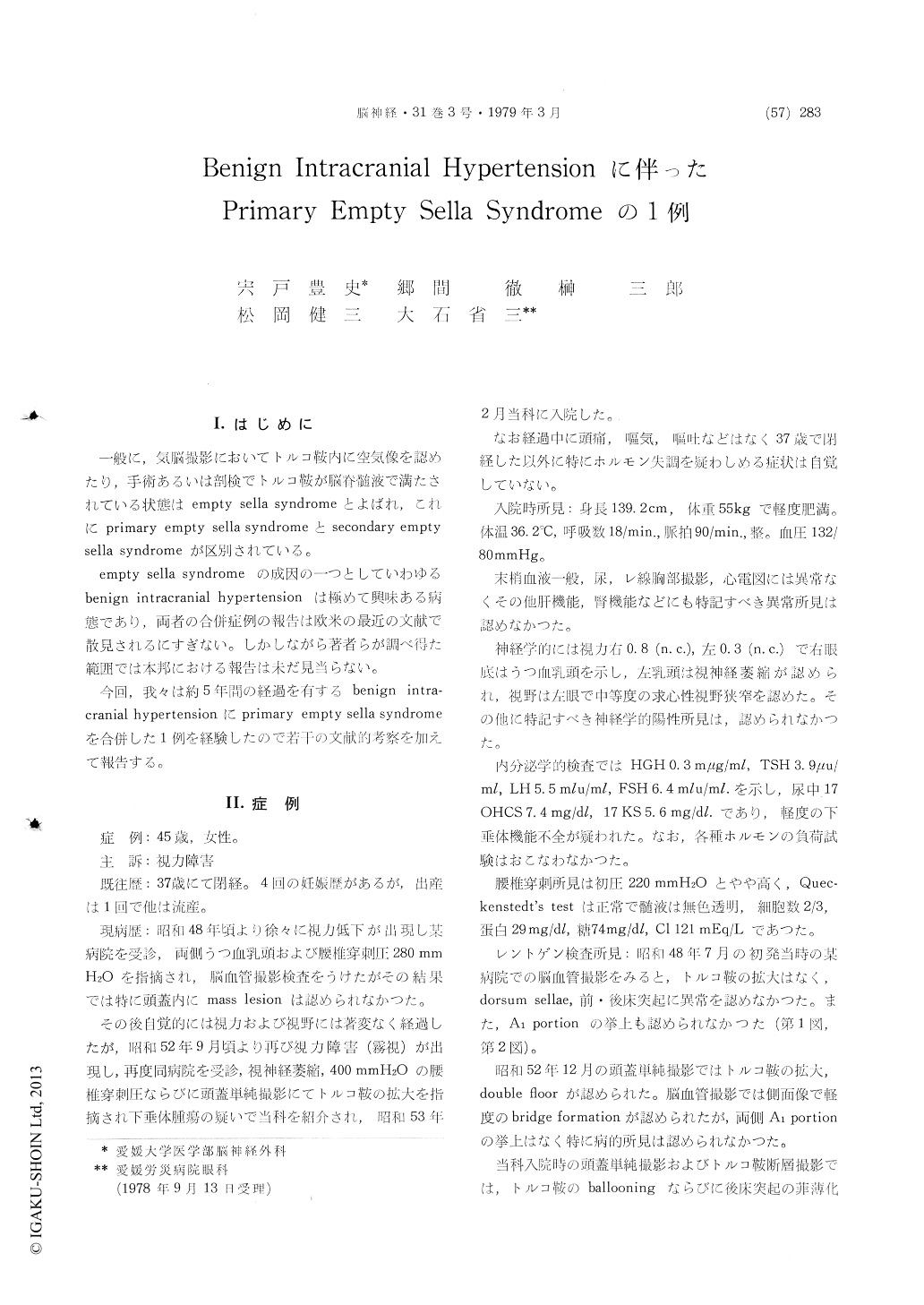Japanese
English
- 有料閲覧
- Abstract 文献概要
- 1ページ目 Look Inside
I.はじめに
一般に,気脳撮影においてトルコ鞍内に空気像を認めたり,手術あるいは剖検でトルコ鞍が脳脊髄液で満たされている状態はempty sella syndromeとよばれ,これにprimary empty sella syndromeとsecondary emptysella syndromeが区別されている。
empty sella syndromeの成因の一つとしていわゆるbenign intracranial hypertensionは極めて興味ある病態であり,両音の合併症例の報告は欧米の最近の文献で散見されるにすぎない。しかしながら著者らが調べ得た範囲では本邦における報告は未だ見当らない。
A case of primary empty sella syndrome associ-ated with benign intracranial hypertension was reported.
A 45-year-old woman was admitted to our clinic in February, 1978 with a 5 years history of visual disturbance. At the beginning of her present illness, she complained of blurred vision without loss of visual field in July, 1973, and was admitted to the hospital. Neurological examinations revealed normal except for bilateral papilledema, and lumbar puncture revealed an opening pressure of 280 mmH2O with normal cerebrospinal fluid chemistries. Left common carotid angiograms showed normal findings, suggesting no intracranial mass lesions. After discharge, her clinical course was not changed.
She was readmitted to the same hospital in December, 1977, because of worsening of visual acuity and development of occasional bouble vision. Neurological examinations on the second admission revealed optic atrophy on the left side. Skull plain films showed an enlargement of sella turcica.
She was then, reffered to our clinic having a diagnosis of suspect of pituitary tumor. There was impairment of visual acuity on both sides ; optic atrophy and concentric contraction of visual field on the left side and papilledema on the right side. Although clinical manifestations due tohormonal disorders was not noticed, the laboratory data apparently demonstrated hypopituitarism. Lumbar puncture revealed an opening pressure of 220 mmH2O with normal cerebrospinal fluid chemistries. Skull plain films demonstrated bal-looning of the sella turcica and the double floor. On pneumoencephalographic examination, sub-archnoid air encroached upon the anterior portion of the sella, demonstrating a herniation of the suprasellar cistern into the sella turcica, which was compatible with the diagnosis of the empty sella syndrome reported before.
In general, the empty sella syndrome is classified into two groups, primary and secondary, according to whether a patient has previously undergone operation or irradiation or not. Impairment ofisual acuity is common symptom for secondary empty sella syndrome due to a herniation of the optic nerves and chiasma into the sella, but not common for primary empty sella syndrome.
It is one of characteristic features in the present case that empty sella syndrome was associated with benign intracranial hypertension. It is likely that raised intracranial pressure will afford the effect of pulsative beat of cerebrospinal fluid upon the sella in the presence of congenital defect of diaphragma sellae, the sella will be enlarged and the pituitary gland displaced posteriorly. It is also considered that intracranial hypertension may take place some part in producing visual disturbance in our case.
Definition, etiological hypotheses, clinical mani-festations and the neuroradiological findings in the vase of empty sella syndrome were discussed.

Copyright © 1979, Igaku-Shoin Ltd. All rights reserved.


